Abstract
Objectives
To evaluate the diagnostic performance of transabdominal high-resolution ultrasound (HRUS) for differentiation of adenomyomatosis from early-stage, wall-thickening-type gallbladder (GB) cancer.
Methods
HRUS was defined as the addition of high megahertz imaging to conventional low megahertz imaging with use of state-of-the-art imaging technology. HRUS findings were retrospectively compared in 45 patients with adenomyomatosis and 28 patients with stage T1/T2 wall-thickening-type GB cancer. For evaluating HRUS performance in the differential diagnosis of adenomyomatosis from GB cancer, receiver operating characteristic curve analysis was used with a five-point confidence scale independently scored by three blinded radiologists who also analysed morphological abnormalities.
Results
The area under the receiver operating characteristic curve (A z) values of HRUS in the diagnosis of adenomyomatosis were 0.948, 0.915 and 0.917 for reviewers 1, 2 and 3. Symmetrical wall thickening, intramural cystic spaces, intramural echogenic foci and twinkling artefacts were significantly associated with adenomyomatosis (P < 0.05), whereas irregular thickening of the outer wall, focal innermost hyperechoic layer (IHL) discontinuity, IHL irregularity, IHL thickening greater than 1 mm, loss of multilayer pattern in the GB wall, and intralesional vascularity were significantly associated with cancer (P < 0.05). The sensitivity, specificity and accuracy of intramural cystic spaces/echogenic foci for the diagnosis of adenomyomatosis were 80.0 %, 85.7 % and 82.2 %.
Conclusions
This study showed that HRUS can be helpful for distinguishing adenomyomatosis from early-stage, wall-thickening-type GB cancer.
Key Points
• Transabdominal high-resolution ultrasound (HRUS) helps differentiate adenomyomatosis from gallbladder cancer.
• HRUS can evaluate the detailed anatomy of the gallbladder wall.
• Adenomyomatosis of the gallbladder shows characteristic findings on HRUS.







Similar content being viewed by others
References
Ching BH, Yeh BM, Westphalen AC, Joe BN, Qayyum A, Coakley FV (2007) CT differentiation of adenomyomatosis and gallbladder cancer. AJR Am J Roentgenol 189:62–66
Stunell H, Buckley O, Geoghegan T, O’Brien J, Ward E, Torreggiani W (2008) Imaging of adenomyomatosis of the gall bladder. J Med Imaging Radiat Oncol 52:109–117
Yoshimitsu K, Honda H, Jimi M et al (1999) MR diagnosis of adenomyomatosis of the gallbladder and differentiation from gallbladder carcinoma: importance of showing Rokitansky-Aschoff sinuses. AJR Am J Roentgenol 172:1535–1540
Haradome H, Ichikawa T, Sou H et al (2003) The pearl necklace sign: an imaging sign of adenomyomatosis of the gallbladder at MR cholangiopancreatography. Radiology 227:80–88
Boscak AR, Al-Hawary M, Ramsburgh SR (2006) Best cases from the AFIP: adenomyomatosis of the gallbladder. Radiographics 26:941–946
Hwang JI, Chou YH, Tsay SH et al (1998) Radiologic and pathologic correlation of adenomyomatosis of the gallbladder. Abdom Imaging 23:73–77
Brambs HJ, Wrazidlo W, Schilling H (1990) The sonographic image of gallbladder adenomyomatosis. Rofo 153:633–636
Rice J, Sauerbrei EE, Semogas P, Cooperberg PL, Burhenne HJ (1981) Sonographic appearance of adenomyomatosis of the gallbladder. J Clin Ultrasound 9:336–337
Raghavendra BN, Subramanyam BR, Balthazar EJ, Horii SC, Megibow AJ, Hilton S (1983) Sonography of adenomyomatosis of the gallbladder: radiologic-pathologic correlation. Radiology 146:747–752
Yoshimitsu K, Honda H, Aibe H et al (2001) Radiologic diagnosis of adenomyomatosis of the gallbladder: comparative study among MRI, helical CT, and transabdominal US. J Comput Assist Tomogr 25:843–850
Oktar SO, Yucel C, Ozdemir H, Uluturk A, Isik S (2003) Comparison of conventional sonography, real-time compound sonography, tissue harmonic sonography, and tissue harmonic compound sonography of abdominal and pelvic lesions. AJR Am J Roentgenol 181:1341–1347
Yen CL, Jeng CM, Yang SS (2008) The benefits of comparing conventional sonography, real-time spatial compound sonography, tissue harmonic sonography, and tissue harmonic compound sonography of hepatic lesions. Clin Imaging 32:11–15
Dahl JJ, Soo MS, Trahey GE (2004) Clinical evaluation of combined spatial compounding and adaptive imaging in breast tissue. Ultrason Imaging 26:203–216
Jang JY, Kim SW, Lee SE et al (2009) Differential diagnostic and staging accuracies of high resolution ultrasonography, endoscopic ultrasonography, and multidetector computed tomography for gallbladder polypoid lesions and gallbladder cancer. Ann Surg 250:943–949
Lee JY, Choi BI, Han JK et al (2005) High resolution ultrasonographic evaluation of the gallbladder: value of advanced imaging techniques. J Korean Soc Ultrasound Med 24:169–175
Kim HC, Yang DM, Jin W, Ryu JK, Shin HC (2010) Color Doppler twinkling artifacts in various conditions during abdominal and pelvic sonography. J Ultrasound Med 29:621–632
Yoon JH, Cha SS, Han SS, Lee SJ, Kang MS (2006) Gallbladder adenomyomatosis: imaging findings. Abdom Imaging 31:555–563
Mizuguchi M, Kudo S, Fukahori T et al (1997) Endoscopic ultrasonography for demonstrating loss of multiple-layer pattern of the thickened gallbladder wall in the preoperative diagnosis of gallbladder cancer. Eur Radiol 7:1323–1327
Gore RM, Yaghmai V, Newmark GM, Berlin JW, Miller FH (2002) Imaging benign and malignant disease of the gallbladder. Radiol Clin North Am 40:1307–1323, vi
Meacock LM, Sellars ME, Sidhu PS (2010) Evaluation of gallbladder and biliary duct disease using microbubble contrast-enhanced ultrasound. Br J Radiol 83:615–627
Imai H, Osada S, Sasaki Y et al (2011) Gallbladder adenocarcinoma with extended intramural spread in adenomyomatosis of the gallbladder with the pearl necklace sign. Am Surg 77:E57–E58
Ishizuka D, Shirai Y, Tsukada K, Hatakeyama K (1998) Gallbladder cancer with intratumoral anechoic foci: a mimic of adenomyomatosis. Hepatogastroenterology 45:927–929
Yoshimitsu K, Irie H, Aibe H et al (2005) Well-differentiated adenocarcinoma of the gallbladder with intratumoral cystic components due to abundant mucin production: a mimicker of adenomyomatosis. Eur Radiol 15:229–233
Author information
Authors and Affiliations
Corresponding author
Rights and permissions
About this article
Cite this article
Joo, I., Lee, J.Y., Kim, J.H. et al. Differentiation of adenomyomatosis of the gallbladder from early-stage, wall-thickening-type gallbladder cancer using high-resolution ultrasound. Eur Radiol 23, 730–738 (2013). https://doi.org/10.1007/s00330-012-2641-9
Received:
Revised:
Accepted:
Published:
Issue Date:
DOI: https://doi.org/10.1007/s00330-012-2641-9




